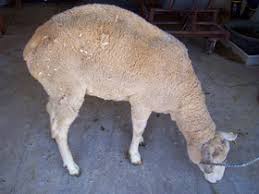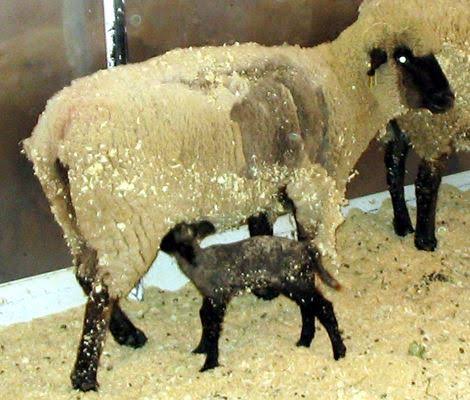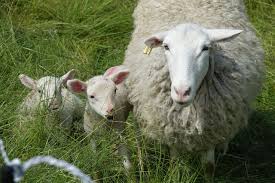Scrapie in sheep and goats, scientifically known as Ovis aries and Capra aegagrus hircus respectively, is a disease that affects the nervous system of these animals. It belongs to a group of diseases called transmissible spongiform encephalopathies (TSEs). Scrapie has been recognized for centuries and is characterized by the accumulation of abnormal protein in the brain, leading to neurological symptoms.
This disease primarily targets the central nervous system, causing affected animals to exhibit changes in behavior, such as nervousness, itching, and incoordination. As the disease progresses, affected sheep and goats may experience weight loss, muscle tremors, and difficulty walking. The name “scrapie” is derived from the intense itching and scraping behavior observed in infected animals.
The infectious agent responsible for scrapie is believed to be an abnormal form of a normal cellular protein, called a prion. Prions are unique in their ability to induce other normal proteins to adopt the abnormal, disease-associated shape. This process leads to the accumulation of these misfolded proteins in the brain, forming microscopic holes that give the tissue a spongy appearance.
Scrapie is primarily transmitted through contact with infected placental tissues during birth or through contaminated environments where infected animals have been. It is important to note that scrapie is not caused by bacteria, viruses, or other conventional infectious agents.
Efforts to control and prevent scrapie involve identifying and culling affected animals, as well as implementing management practices to reduce the spread of the disease within flocks and herds. Selective breeding programs have also been established to develop sheep and goat populations with increased resistance to scrapie.
Research continues to unravel the complexities of scrapie, with a focus on understanding the prion protein and developing strategies for its detection and control. Monitoring and surveillance programs are crucial in identifying and managing scrapie outbreaks, ensuring the health and well-being of sheep and goat populations.
Scrapie in sheep and goats is a significant concern due to its impact on animal welfare and agricultural economies. Scientific efforts to understand and combat this disease contribute to the development of effective strategies for its control and prevention within livestock populations.
Read Also: Rose Chafer: Description, Damages Caused, Control and Preventive Measures
Animals Affected by Scrapie in Sheep and Goats

Scrapie primarily affects sheep and goats, as indicated by its name. Within these species, various breeds can be susceptible to the disease. While the manifestation of scrapie is more commonly observed in adult animals, it can affect sheep and goats of all ages.
The disease has been documented in different breeds worldwide, and susceptibility can vary among them. Certain genotypes, or genetic makeups, are associated with increased susceptibility to scrapie. For instance, studies have identified specific genetic markers that make some sheep and goats more prone to developing the disease.
It’s important to note that scrapie is not limited to a particular geographical region or specific farming practices. It has been reported in diverse environments, affecting both intensively managed flocks and those with more extensive grazing systems.
Efforts to manage and control scrapie often involve genetic selection, with the aim of breeding animals that are less susceptible to the disease. Identifying and removing infected animals from breeding programs is another strategy to reduce the prevalence of scrapie within flocks and herds.
Overall, while scrapie primarily impacts sheep and goats, the susceptibility and prevalence of the disease can be influenced by various factors, including genetic traits and management practices. Understanding these dynamics is crucial for implementing effective control measures and safeguarding the health of these animal populations.
Damages Caused by Scrapie in Sheep and Goats

Scrapie in sheep and goats can have significant economic and animal welfare implications. The disease causes damage primarily through its impact on the nervous system, leading to various symptoms that affect the well-being of affected animals.
1. Neurological Damage: Scrapie induces degeneration in the brain, resulting in neurological abnormalities. Affected animals may exhibit behavioral changes such as nervousness, intense itching, and incoordination. As the disease progresses, more severe symptoms, including muscle tremors and difficulty walking, become evident.
2. Reduced Productivity: Infected animals may experience weight loss and a decline in overall health. This can lead to reduced productivity in terms of meat, milk, and wool production. The economic losses associated with decreased productivity can be substantial for farmers and the livestock industry.
3. Increased Mortality: Scrapie can contribute to higher mortality rates in affected flocks and herds. Animals exhibiting severe neurological symptoms may become more susceptible to injuries or accidents, leading to premature death. Additionally, culling infected animals is a common strategy to prevent the spread of the disease, further impacting herd or flock numbers.
4. Trade Restrictions: The presence of scrapie can result in trade restrictions for affected regions. International regulations often require stringent measures to control and eradicate transmissible spongiform encephalopathies (TSEs) like scrapie. These restrictions can have economic repercussions on the export and import of live animals and animal products.
5. Management Costs: Controlling and managing scrapie outbreaks require significant financial resources. Costs may include diagnostic testing, surveillance programs, and the implementation of biosecurity measures to prevent the spread of the disease. These expenses can strain the financial resources of individual farmers and contribute to broader economic impacts on the livestock industry.
6. Genetic Impact: Selective breeding programs aimed at reducing susceptibility to scrapie may alter the genetic diversity within sheep and goat populations. While these programs are designed to control the disease, they can also influence the overall genetic makeup of the livestock, requiring careful management to maintain genetic diversity.
The damages caused by scrapie in sheep and goats extend beyond the immediate health concerns of individual animals. The economic, trade-related, and genetic impacts emphasize the importance of effective control measures to mitigate the consequences of this neurodegenerative disease in livestock populations.
Rrad Also: Black Spot (Rose Disease): Description, Damages Caused, Control and Preventive Measures
Control and Preventive Measures

Controlling and preventing scrapie in sheep and goats involves a combination of management practices, surveillance, and genetic strategies. Implementing effective measures is crucial to reduce the spread of the disease and mitigate its impact on animal health and agricultural economies.
1. Genetic Selection: Breeding programs focus on selecting animals with genotypes that demonstrate resistance to scrapie. Identifying and breeding from animals less susceptible to the disease can help reduce its prevalence within flocks and herds over time.
2. Culling Infected Animals: Identifying and removing animals showing clinical signs of scrapie is a common practice to prevent the spread of the disease. This includes implementing strict culling measures for affected individuals and those genetically predisposed to the condition.
3. Surveillance Programs: Regular monitoring and surveillance for scrapie are essential to detect cases early and implement control measures promptly. This involves testing animals, especially those displaying clinical signs, and conducting epidemiological investigations to trace the source of infection.
4. Biosecurity Measures: Implementing biosecurity practices on farms can help prevent the introduction and spread of scrapie. This includes controlling access to the farm, quarantining new arrivals, and maintaining clean and sanitized facilities to reduce environmental contamination.
5. Record Keeping: Maintaining accurate and detailed records of animal movements, births, and deaths is crucial for traceability and disease management. This information aids in identifying potential sources of infection and implementing control measures effectively.
6. Education and Awareness: Providing education to farmers, veterinarians, and other stakeholders about scrapie, its clinical signs, and preventive measures is essential. Increased awareness helps ensure that individuals involved in animal husbandry are equipped to identify and report potential cases promptly.
7. International Collaboration: Collaborating with international organizations and adhering to global standards for scrapie control is important, especially considering trade restrictions related to transmissible spongiform encephalopathies. This collaboration can enhance the effectiveness of control measures and contribute to global efforts to manage the disease.
8. Research and Innovation: Investing in research to understand the biology of scrapie, develop diagnostic tools, and explore new control strategies is crucial. Ongoing scientific advancements contribute to the refinement and improvement of measures for controlling and preventing the disease.
However, a comprehensive approach that combines genetic selection, culling of infected animals, surveillance, biosecurity, education, international collaboration, and ongoing research efforts is necessary to effectively control and prevent scrapie in sheep and goats. Implementing these measures collectively contributes to the overall health and sustainability of livestock populations.
Frequently Asked Questions (FAQs) About Scrapie in Sheep and Goats
Q1: What is scrapie, and why is it called that?
A: Scrapie is a neurodegenerative disease affecting sheep and goats. The name originates from the intense itching and scraping behavior observed in infected animals.
Q2: How is scrapie transmitted among sheep and goats?
A: Scrapie is primarily transmitted through contact with infected placental tissues during birth or exposure to contaminated environments where infected animals have been.
Q3: Are only specific breeds susceptible to scrapie?
A: No, scrapie can affect various sheep and goat breeds. However, susceptibility may vary, and certain genetic markers can influence an individual’s likelihood of developing the disease.
Q4: What are the common signs of scrapie in sheep and goats?
A: Clinical signs include nervousness, intense itching, incoordination, muscle tremors, and difficulty walking. Behavioral changes and weight loss may also occur.
Q5: Can scrapie be transmitted to humans?
A: No, there is no evidence that scrapie can be transmitted to humans. Scrapie belongs to a group of diseases called transmissible spongiform encephalopathies (TSEs), but each TSE typically affects specific species.
Q6: How is scrapie diagnosed in sheep and goats?
A: Diagnosis involves post-mortem examination of the brain for characteristic lesions. Live-animal testing using specific diagnostic methods is also available.
Q7: Can scrapie be controlled through genetic selection?
A: Yes, genetic selection for resistance to scrapie is a common control measure. Breeding programs aim to reduce susceptibility by identifying and breeding from animals with resistance-associated genotypes.
Q8: What measures can farmers take to prevent scrapie on their farms?
A: Implementing biosecurity measures, maintaining detailed records, participating in surveillance programs, and promptly culling infected animals are key preventive actions.
Q9: Are there trade restrictions related to scrapie?
A: Yes, international regulations may impose trade restrictions on regions with confirmed cases of scrapie. Compliance with global standards is essential for managing these restrictions.
Q10: Is there ongoing research on scrapie?
A: Yes, ongoing research aims to deepen our understanding of scrapie, develop better diagnostic tools, and explore innovative control strategies to manage and prevent the disease in sheep and goats.
Read Also: Guide to Waste Management Industry Trends
